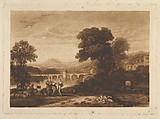Apuleia in Search of Apuleius, unpublished plate from "Liber Studiorum"
Designed and etched by Joseph Mallord William Turner British
Engraver William Say British
Not on view
Intended as part of Turner's "Liber Studiorum" (Latin for Book of Studies), but never published by the artist, this engraver's proof was made as Say added mezzotint to develop tone under Turner's direction. The composition derives from a premium-winning painting shown at the British Institution in 1814, now at the National Gallery, London. In the foreground, Apuleia, whom Turner invented as a wife for a shepherd mentioned in Ovid's" Metamorphoses," unveils herself to a group of shepherdesses. The landscape is enlivened by a multi-arched classical bridge that spans a river near a temple, and the composition embodies Arcadian qualities associated with Claude. The finished plate was sold in 1873 with other unpublished Liber compositions, and subsequently printed and circulated.
Due to rights restrictions, this image cannot be enlarged, viewed at full screen, or downloaded.


